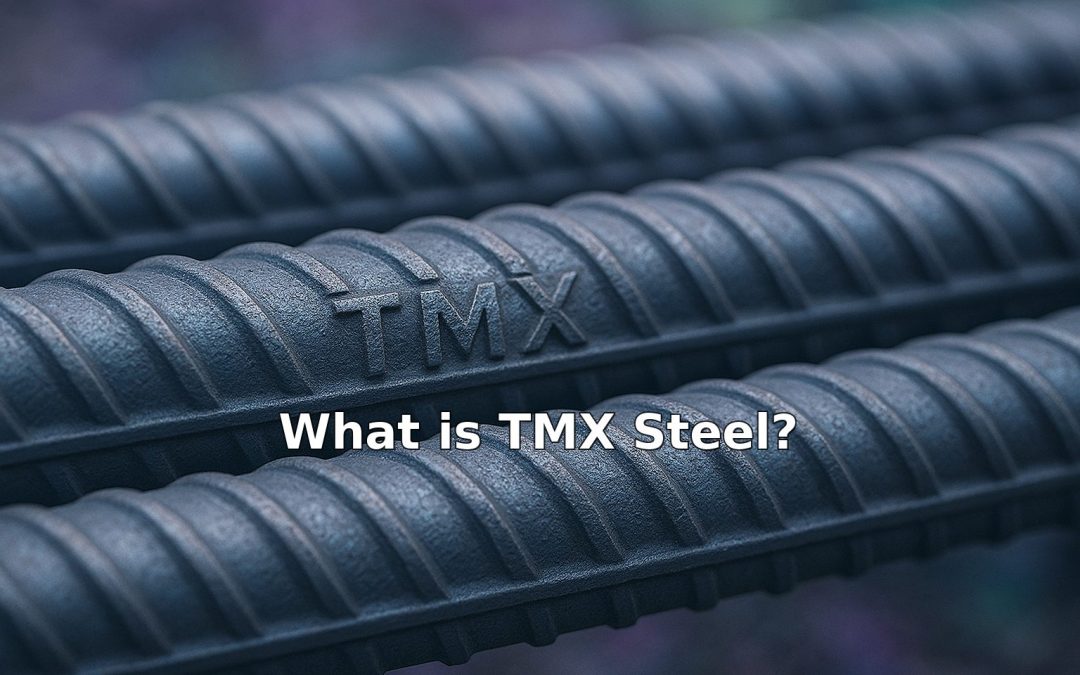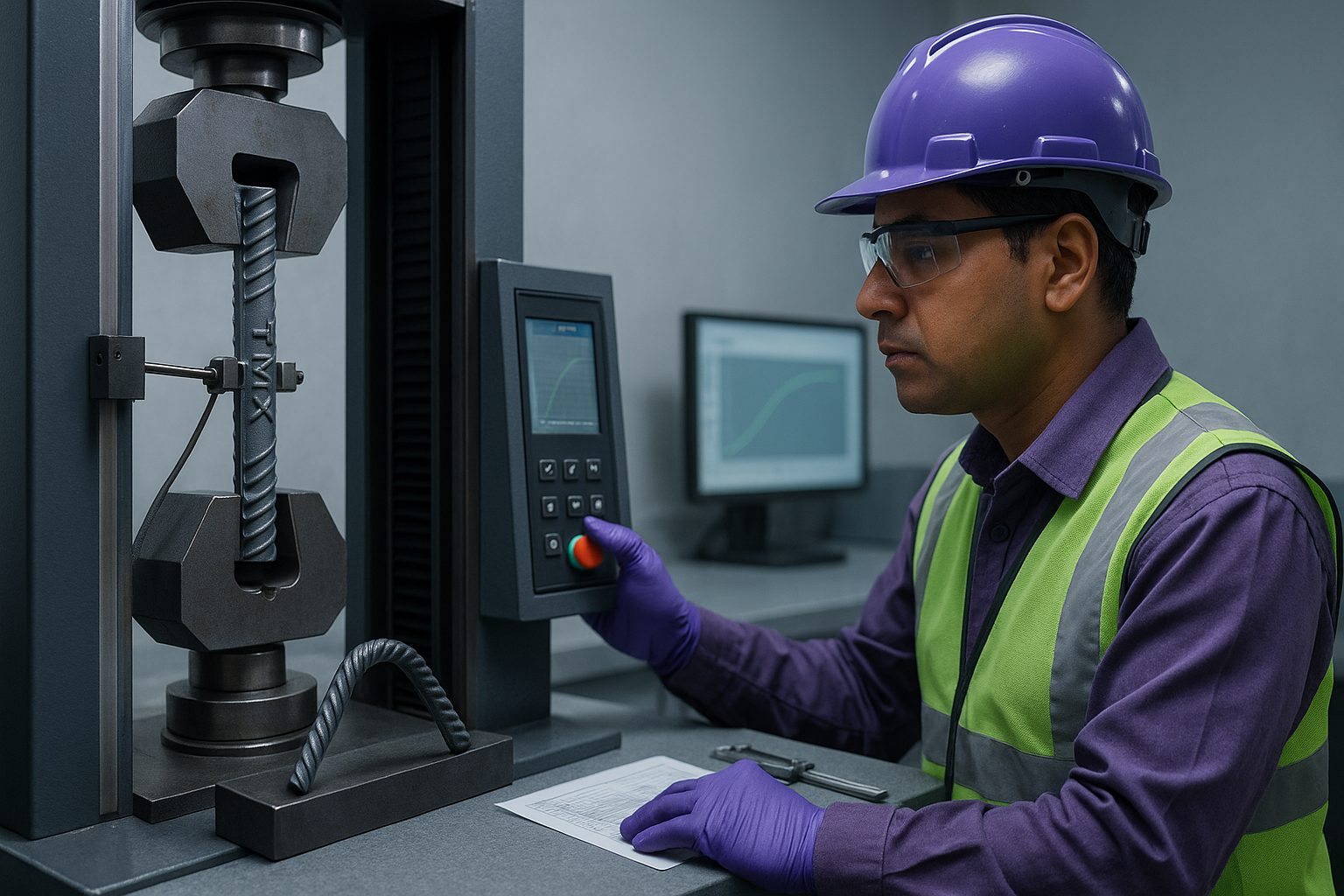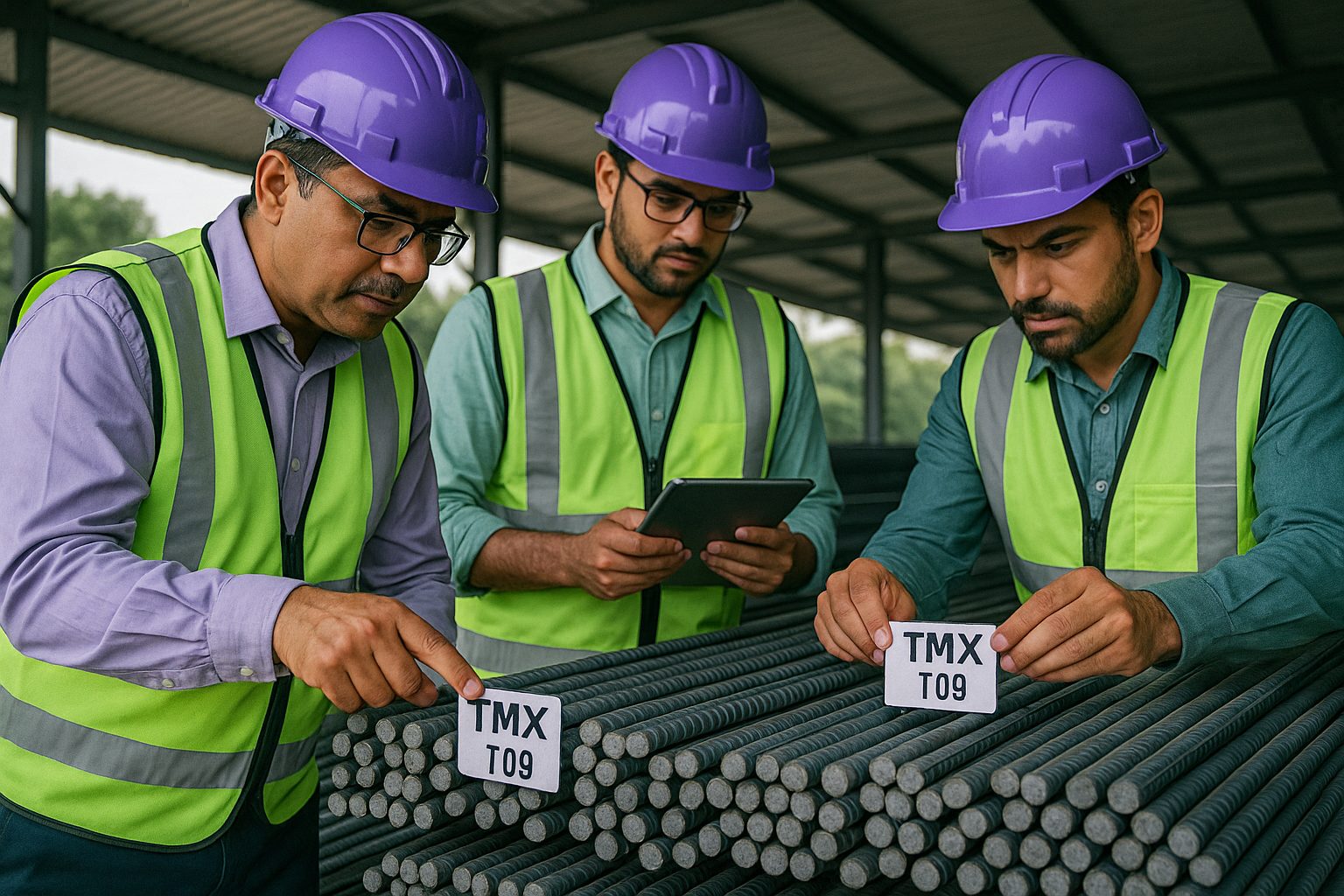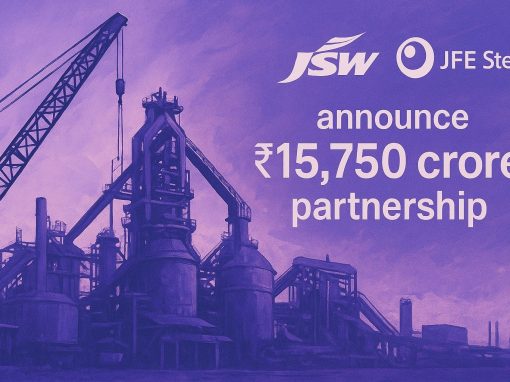Table of Contents
Introduction
India’s construction sector is growing fast, and one material that has steadily earned attention among builders and small contractors for its strength and reliability is TMX steel.
It is manufactured through the Thermex process. This new-generation rebar offers higher ductility, better weldability, and consistent quality control. It is German technology that makes TMX steel increasingly relevant for business across India, managing cost-sensitive projects.
For small and mid-scale enterprises engaged in public or private construction work, the choice of reinforcement steel often determines not just structural stability but also compliance with BIS and tender norms. TMX steel, when sourced correctly, can help meet those quality standards while reducing risks linked to corrosion, welding faults, delayed approvals, etc.
This article serves as a comprehensive guide for business owners. It assists you in understanding, in simple terms, what TMX steel is, how it differs from conventional TMT bars, and what builders and contractors should check before procurement. As it helps share practical steps for testing, verifying supplier credentials and on-site handling – knowledge essential for every business building safely, economically, and within compliance.
What is TMX steel?
TMX full form is Thermex steel and are high-quality TMT bars (thermo mechanical treatment). They are manufactured using Thermex Technology, a German patent technology (also known as Thermax) that makes the steel bars strong, weldable and increases its tensile strength. Thermex TMT bars are also highly heat and fire resistant that makes it safe to use them in construction projects (especially buildings).
TMX steel full form:
Thermex steel or as commonly called new generation steel bar or fresh generation high strength steel.
How TMX steel is made
Every TMX bar derives its reliability from the precision of its production. The process focuses on temperature control and uniform cooling, ensuring that each bar achieves the balance of strength and flexibility required for structural safety. Unlike older steel rebar technologies that rely only on alloy composition, TMX gains its performance from the way heat is managed during rolling and cooling.
The Thermex manufacturing process
The making of TMX steel follows a series of well-defined stages designed to maintain metallurgical consistency:
- Billet heating: High-quality steel billets are heated to around 1,000°C, preparing them for shaping.
- Rolling: The heated billets pass through rolling stands to achieve the required diameter and rib pattern.
- Rapid water cooling: Immediately after rolling, the red-hot bars move through the Thermex cooling line, where high-pressure water jets cool the outer layer in seconds.
- Self-tempering: The core heat then tempers the hardened surface naturally, resulting in a strong shell and a flexible core.
- Final cooling and inspection: Bars are allowed to cool at ambient temperature, checked for uniform hardness, and tested to ensure they meet IS 1786 quality benchmarks.
This scientific control over heat and pressure gives TMX its dependable mechanical properties – a crucial factor for MSMEs focused on structural quality and compliance.
Key properties of TMX steel
Now that we understand TMX steel’s meaning and its manufacturing process, let us look at its key characteristics or properties. So, the real advantage of TMX steel lies in its balanced mechanical and chemical properties – features that translate into measurable performance on-site. For small and medium-sized builders, contractors, and project engineers, understanding these properties helps in choosing the right grade for different structural needs and in ensuring compliance with BIS standards.
Mechanical and Performance attributes
- High tensile strength: TMX bars exhibit excellent yield and tensile ratios, making them ideal for load-bearing components in high-rise or industrial structures.
- Improved ductility: The inner ferrite-pearlite core allows the bar to bend without cracking, which simplifies fabrication at site and reduces rework.
- Superior weldability: Controlled carbon content in steet ensures smooth joints during welding, reducing the need for additional finishing or filler materials.
- Enhanced elongation: With elongation values ranging between 16%–23%, TMX bars perform better under dynamic stress and during seismic events.
- Corrosion resistance: The Thermex method of manufacturing German TmX Fe 550 (for instance) makes it corrosion resistant. The raw steel used for TMX bars have less carbon content (0.15%) and hence are more resistant to corrosion. There is less scale and carbide formation during manufacturing, further making the steel corrosion resistant.
- Better bonding with concrete: The uniform rib pattern offers improved grip, strengthening the concrete-steel interface and reducing the risk of slippage under load.
For MSMEs executing government or private construction projects, these properties ensure predictable behaviour of the reinforcement steel, consistent quality in testing, and longer life for the completed structure – all vital for cost control and compliance during audits.
Is TMX steel the right choice for your project?
Choosing between different types of reinforcement steel isn’t just a technical call – it’s a business decision. For MSMEs working on tight budgets or government-linked construction contracts, the choice directly impacts compliance, durability, and the total cost of ownership. TMX steel is best suited for projects that demand higher ductility, consistent quality, and long-term resistance to heat or corrosion.
When TMX steel adds real value
- Seismic or high-stress zones: TMX bars perform exceptionally well in regions prone to earthquakes or vibration due to their superior elongation and flexibility.
- Industrial and infrastructure projects: In factories, bridges, or public utilities, the bars’ strength and uniformity help reduce inspection rejections and welding delays.
- Structures requiring longevity: For coastal projects or high-humidity areas, TMX’s corrosion resistance lowers maintenance and repair costs over time.
- Compliance-driven projects: Since most TMX grades meet IS 1786 standards, using them can ease audit checks and speed up tender approvals for MSME contractors.
While TMX steel is priced slightly higher than standard TMT bars, the investment often pays off through fewer site rejections, reduced material wastage, and longer service life. For builders focused on delivering projects that must clear structural audits smoothly, TMX provides a practical balance between performance, reliability, and long-term cost efficiency.
TMX vs TMT: What’s the Difference?
Many buyers use the terms TMX and TMT interchangeably, yet there are important differences between the two. Both are types of thermo-mechanically treated rebars, but they use distinct cooling technologies and deliver slightly different mechanical outcomes.
Understanding this distinction helps MSME contractors make informed procurement choices, especially when projects demand specific structural performance or tender compliance. Let’s have a closer look at the technical and practical differences between TMX and TMT.
TMX vs TMT
| Feature | TMX Steel | TMT Steel |
| Cooling Technology | Uses Thermex (German) process – precise water pressure control for consistent quenching | Uses Tempcore (Belgian) process – standard quenching and self-tempering |
| Surface Quality | Cleaner surface with uniform hardness; better corrosion resistance | May show minor variation depending on cooling uniformity |
| Ductility & Elongation | Higher elongation (up to 23%) – performs well in seismic zones | Slightly lower elongation (around 14–18%) |
| Weldability | Excellent due to lower carbon content | Good, but varies by mill composition |
| Cost Factor | Moderately higher, offset by reduced rework and longer life | Lower upfront cost, but may need closer QA at site |
| Best Suited For | Industrial, seismic, or compliance-heavy projects | General construction and budget-driven works |
For MSMEs, the practical takeaway is simple – TMX offers tighter quality control and longer durability, while TMT remains viable for cost-sensitive projects. The right choice depends on the project’s technical needs, environmental exposure, and required certification level.
How to source TMX steel from verified suppliers in India
Finding the right supplier is as important as choosing the right grade of steel. German Thermex bars make up almost 70-80% of the market in India as more and more businesses are considering using TMX steel in their projects. There are several Top German TMX manufacturers and companies in India today where you can buy steel.
For MSMEs, the procurement process must balance price, quality certification, and logistics reliability. TMX steel is produced by several licensed Indian manufacturers under the Thermex process, and it’s widely available through authorised distributors and online B2B platforms. However, not every seller adheres to the same testing or documentation standards – a common cause of inspection rejections in construction projects.
Practical sourcing and verification checklist
- Verify Thermex licence and BIS certification: Only buy from mills or distributors holding valid BIS IS 1786 certification and a Thermex licence.
- Request the Mill Test Certificate (MTC): Ensure each batch carries heat numbers and chemical composition data matching your purchase order.
- Check for grade marking and rib pattern: The bar surface should clearly display the grade (e.g., Fe 500, Fe 550) and manufacturer code.
- Ask for third-party lab test reports: Accredited labs such as NABL-approved facilities provide independent verification of tensile and elongation values.
- Review delivery logistics: Confirm lead times, minimum order quantities, and unloading support – essential for smaller builders operating without large storage yards.
Reliable sourcing not only guarantees compliance but also simplifies billing, inspection, and warranty documentation. Many verified platforms and service providers now streamline procurement for small enterprises, offering secure transactions and doorstep delivery across key industrial clusters.
On-site handling and testing protocols for TMX steel
Even the best steel can underperform if it’s not handled properly once it reaches the site. For MSME builders and contractors, maintaining the quality of TMX steel after delivery is as critical as sourcing it from a verified supplier. Small errors during unloading, storage, or steel fabrication can affect the bar’s performance and lead to costly rework later
Best Practices for Handling TMX Bars
- Inspect on arrival: Check grade markings, manufacturer tags, and physical straightness before unloading. Reject bent or rusted bars immediately.
- Use wooden supports: When stacking, place wooden battens between layers to prevent direct ground contact and moisture absorption.
- Cover against weather: Store bars under a waterproof sheet or in a shed to avoid rust, particularly during the monsoon or in coastal regions.
- Separate by grade and length: Keep Fe 500 and Fe 550 bars in clearly labelled stacks to avoid mix-ups during fabrication.
Quick on-Site quality checks
- Bend and rebend test: Ensures the bar can handle the required curvature without cracking.
- Visual surface check: Look for a consistent rib pattern and a clean surface finish.
- Verification of test reports: Match batch numbers on MTCs with supplier invoices for audit readiness.
Implementing these checks safeguards compliance and extends the life of reinforced structures, reducing maintenance costs and site-level disputes.
Also read: Top 10 TMT Bars in India – Know which is best for your project
TMX steel applications in construction
Every construction material earns its credibility through performance in the field, and TMX steel is no exception. Across India, contractors and MSME builders have reported measurable gains in project efficiency and long-term durability when using TMX bars – especially in structures exposed to high stress or varying climatic conditions. The material’s consistency under load and its predictable behaviour during fabrication make it a dependable choice for both small and large-scale works.
Practical applications where TMX excels
- Seismic-prone zones: TMX bars with higher elongation have proven effective in earthquake-resistant building designs, allowing structures to absorb vibrations without major cracking.
- Industrial and commercial buildings: In projects with continuous load cycles or heavy machinery, the bars’ high tensile strength reduces fatigue over time.
- Public infrastructure: Bridges, flyovers, and water-retaining structures benefit from TMX’s corrosion resistance and uniform strength, reducing maintenance costs for local contractors.
- Residential and mid-rise projects: The bars’ easy bendability and weldability shorten fabrication time and lower rework, which matters to MSMEs working on tight deadlines.
These applications show that TMX steel isn’t just about superior manufacturing – it’s about reliability at scale. For builders aiming to meet audit-ready construction standards while staying cost-efficient, TMX delivers a material advantage that extends well beyond the project handover.
Conclusion: Making the right steel choice for long-term value
Selecting the right reinforcement steel is more than a technical decision – it is an operational strategy that affects safety, compliance, and profitability. For Indian MSMEs, where margins are tight and project schedules are often linked to tender deadlines, using a reliable material like TMX steel can significantly reduce post-construction risks and inspection-related delays.
TMX bars offer consistency in mechanical performance, ease of fabrication, and strong compliance alignment with IS 1786 standards. When procured from verified sources and handled with proper on-site discipline, they help contractors deliver structures that meet both regulatory and client expectations. Over time, fewer quality disputes, lower repair frequency, and improved lifecycle durability translate directly into financial gains.
For small and mid-sized builders aiming to grow sustainably in India’s competitive construction market, investing in the right steel isn’t just a matter of material choice – it’s a business advantage. TMX steel, when used responsibly, supports that vision.
Looking to procure steel?
Tata nexarc helps manufacturers, builders and MSMEs source certified steel products, compare prices, and choose the right grade as per IS codes—with complete traceability and procurement confidence.
FAQs
What makes TMX steel suitable for commercial construction projects?
Is TMX steel approved for government and institutional projects?
How does TMX steel benefit MSMEs in tender-based work?
Can TMX steel help reduce total project costs for small builders?
How should MSMEs verify the authenticity of a TMX steel supplier?
What documentation should be maintained when purchasing TMX steel for tenders?
Does TMX steel offer better performance in automated fabrication yards?
Can TMX steel support MSMEs bidding for infrastructure or EPC contracts?
Are there minimum order quantities (MOQs) for TMX steel from manufacturers?
How can MSMEs manage logistics for TMX steel deliveries?
Charul is a content marketing professional and seasoned content writer who loves writing on various topics with 3 years of experience. At Tata nexarc, it has been 2 years since she is helping business to understand jargon better and deeper to make strategical decisions. While not writing, she loves listing pop music.















How readily available are Rudra TMX bars in the Ahmedabad market? they are good amt of distributors and retailers for it? if anyone can share contacts? i want for my jamnagar unit
TMX bars are clearly more expensive than TMT bars. In real-world applications, how do builders and contractors typically justify the higher cost of TMX, especially for projects where fire resistance might not be a significant concern?